AtLAST Predictions¶
Here, you can find another example on how to use maria for making predictions/forecasts of a small instrument that could be mounted on AtLAST. At full capabilities, AtLAST will have a broad 2-degree field of view (FOV) and offer a 10” resolution at 150 GHz. This configuration provides a more comprehensive, high spatial dynamic range, ideal for observing phenomena such as the Sunyaev-Zeldovich effect in galaxy clusters. Here, we will simulate an instrument that uses the 1-degree FoV. To speed
up the simulation a bit.
Furthermore, this tutorial shows how to adjust the simulation setup to accommodate our instrument and telescope design.
[1]:
import matplotlib.pyplot as plt
import scipy as sp
import numpy as np
Setting up the simulation¶
[2]:
import maria
Import the map¶
A big FoV requires a big cluster to scan over. So let’s import one:
[3]:
from maria.io import fetch
map_filename = fetch("maps/big_cluster.fits")
input_map = maria.map.read_fits(filename=map_filename,
width=1., #degrees
index=1,
center=(300.0, -10.0), #RA and Dec in degrees
units ='Jy/pixel'
)
input_map.to(units="K_RJ").plot()
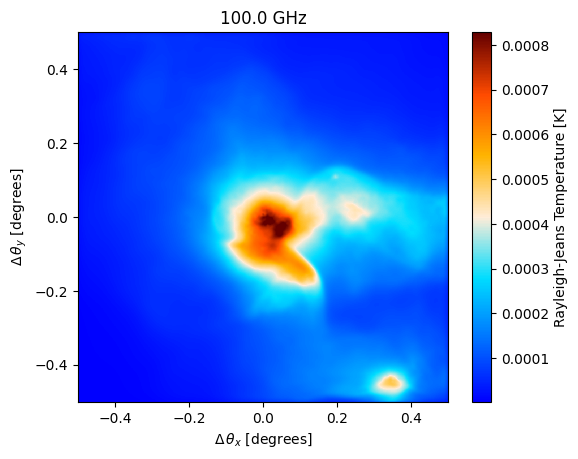
Define the observing plan¶
To make predictions for AtLAST, several adjustments are required. Firstly, we need to change the pointing center. AtLAST is located in the southern hemisphere, so we set the pointing center to a Declination of -10. Additionally, we change the observing date. The default is set to mid-February at 6 am UT, an ideal time for observing with MUSTANG-2 on the GBT but not for AtLAST at Chajnantor. To achieve this, we modify the start_time key to August. This change also necessitates adjusting the
Right Ascension (RA) of the pointing to ensure that the source remains above the horizon during the observation.
[4]:
plan = maria.get_plan(scan_pattern="daisy",
scan_options={"radius": 0.25, "speed": 0.5}, # in degrees
duration=60, # in seconds
sample_rate=225, # in Hz
start_time = "2022-08-10T06:00:00",
scan_center=(300.0, -10.0),
frame="ra_dec")
plan.plot()
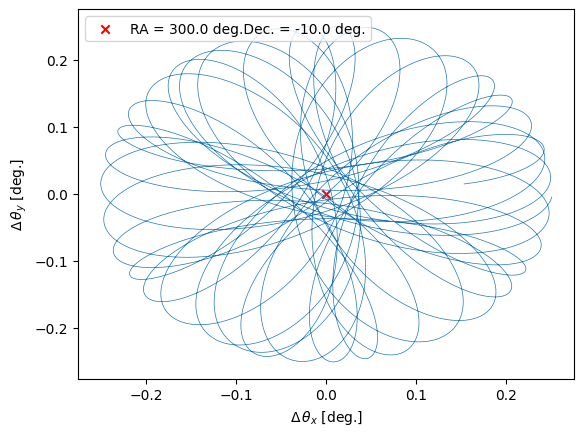
Define the instrument¶
We set the field of view to 1 degree and set the daisy scan’s scan radius to 0.5 degrees. We also adjust the detector bandwidth to 52 GHz.
Now, it’s important to note that simulating such a large FoV and spacing the detectors at 2 f-lambda results in a large detector counts. Therefore, we are simulating ~10000 detectors! This creates a bit of memory issue. Therefore, this simulation cannot (most likely) be run on your laptop but needs a bigger server
[5]:
from maria.instrument import Band
f090 = Band(center=92, # in GHz
width=40.0,
knee=1,
sensitivity=6e-5) # in K sqrt(s)
f090.plot()
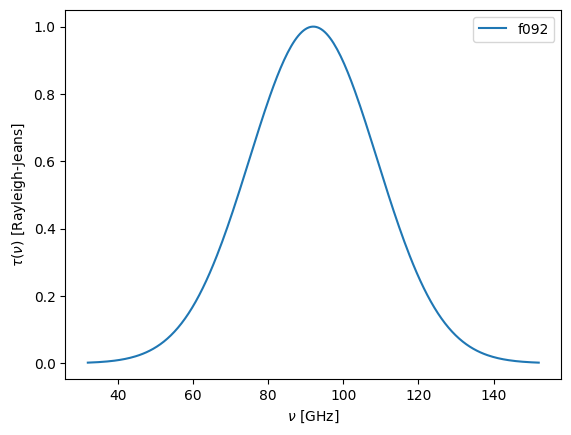
[6]:
array = {"field_of_view": 1.0, "bands": [f090]}
instrument = maria.get_instrument(array=array, primary_size=50, beam_spacing = 2)
instrument.plot()
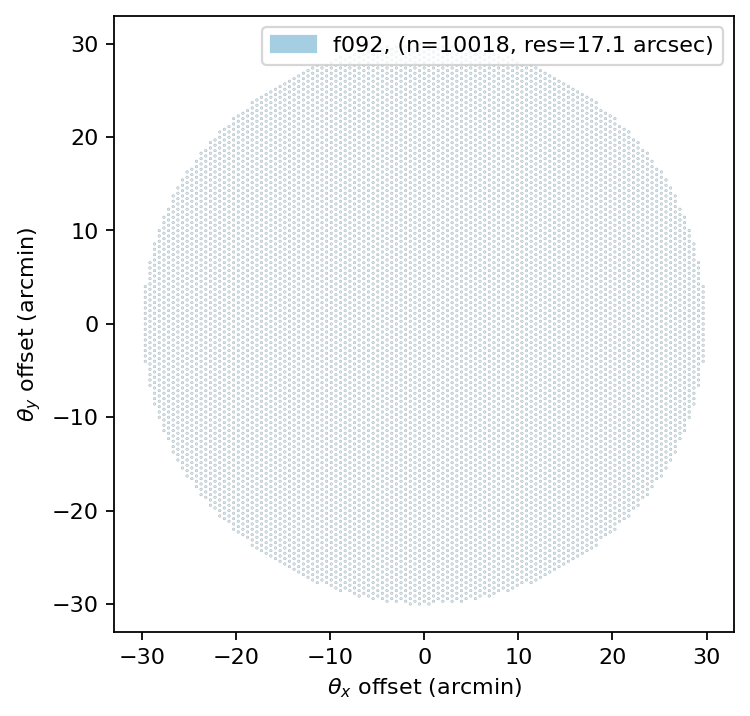
Combine it and get the TOD¶
[7]:
sim = maria.Simulation(instrument,
plan=plan,
site="llano_de_chajnantor",
map=input_map,
atmosphere="2d",
cmb="generate",
)
2024-07-03 10:36:23.898 INFO: Constructed instrument.
2024-07-03 10:36:23.898 INFO: Constructed plan.
2024-07-03 10:36:23.899 INFO: Constructed site.
2024-07-03 10:36:24.902 INFO: Constructed boresight.
2024-07-03 10:36:33.173 INFO: Constructed offsets.
Initialized base in 9277 ms.
Initializing atmospheric layers: 100%|███████████████████████████| 4/4 [00:02<00:00, 1.66it/s]
Generating CMB: 0%| | 0/1 [00:00<?, ?it/s]2024-07-03 10:36:41.857 INFO: Sigma is 0.000000 arcmin (0.000000 rad)
2024-07-03 10:36:41.858 INFO: -> fwhm is 0.000000 arcmin
Generating CMB: 100%|████████████████████████████████████████████| 1/1 [00:02<00:00, 2.45s/it]
[8]:
tod = sim.run()
Generating noise: 100%|██████████████████████████████████████████| 1/1 [00:24<00:00, 24.44s/it]
Generating atmosphere: 4it [00:19, 4.81s/it]
Computing atm. emission (f092): 100%|████████████████████████████| 1/1 [01:32<00:00, 92.82s/it]
Computing atm. transmission (f092): 100%|████████████████████████| 1/1 [01:19<00:00, 79.98s/it]
Sampling CMB (f092): 100%|███████████████████████████████████████| 1/1 [00:01<00:00, 1.95s/it]
Sampling map (f092): 100%|███████████████████████████████████████| 1/1 [01:11<00:00, 71.83s/it]
[9]:
tod.plot()
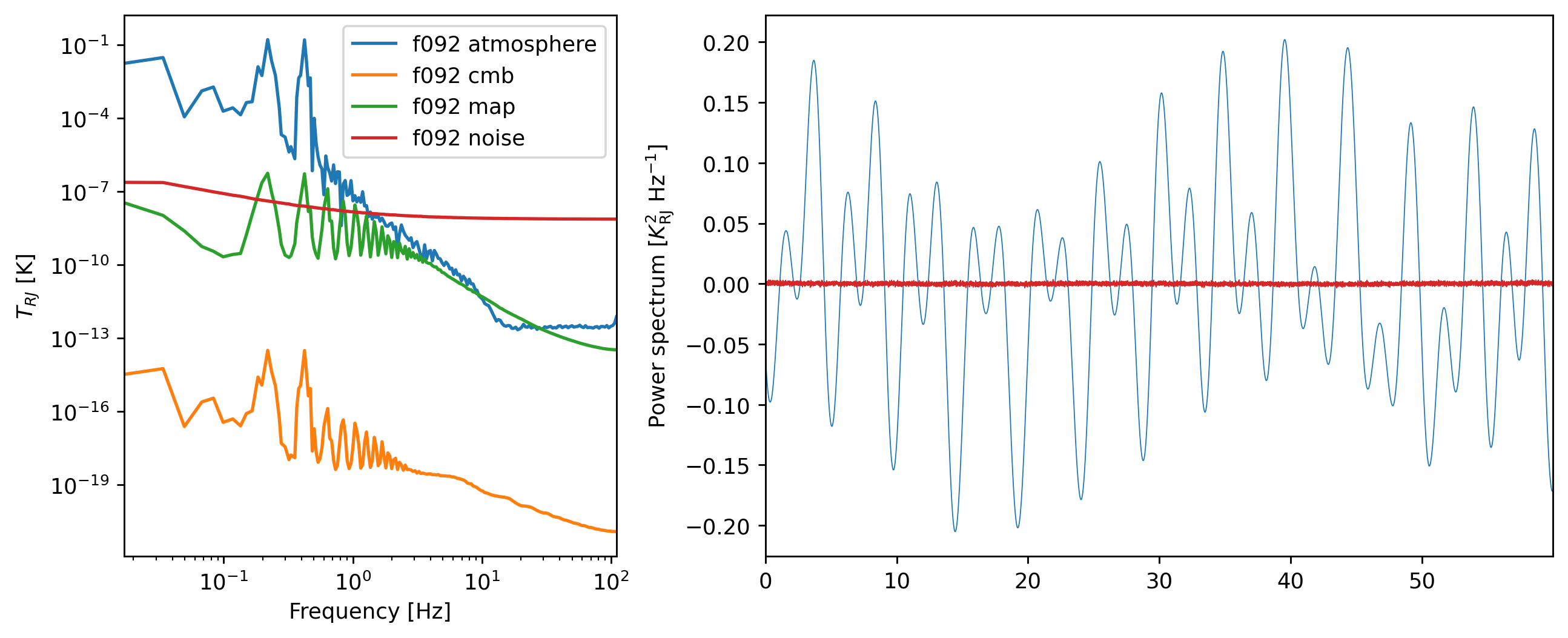
Visualizing the TOD Data¶
In this section, we present the same array and TOD visualizations as in the MUSTANG-2 case, but this time for AtLAST:
Map-Making¶
The mapper we used is similar to the M2 case, it is just binned over a much larger FoV.
[10]:
from maria.map.mappers import BinMapper
mapper = BinMapper(center=(300.0, -10.0),
frame="ra_dec",
width=1.,
height=1.,
resolution=np.degrees(np.nanmin(instrument.fwhm))/4.,
tod_postprocessing={
"window": {"tukey": {"alpha": 0.1}},
"remove_modes": {"n": 1},
"highpass": {"f": 0.05},
"despline": {"spacing": 10},
},
map_postprocessing={
"gaussian_filter": {"sigma": 1},
"median_filter": {"size": 1},
},
)
mapper.add_tods(tod)
output_map = mapper.run()
Running mapper (f092): 100%|████████████████████████████████████| 1/1 [02:39<00:00, 159.54s/it]
Let’s show the results¶
[11]:
output_map.plot()
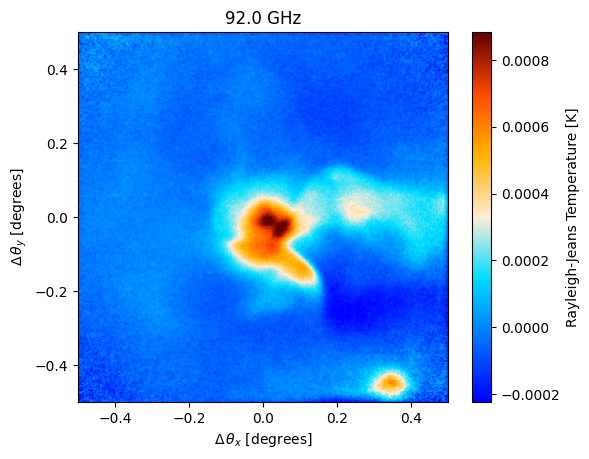
[12]:
output_map.to_fits('/tmp/simulated_map.fits')